|
Your Family Tree
|
February 2005
 |
Website Guide: Search for birth, marriage and deaths certificates, and discover some unique additional features too |
FIND CERTIFICATES AT
BMDINDEX.CO.UK |
|
Coupled with the fact that you can now order copies of certificates from your own computer, online General Register Office indexes now make it possible to perform at least one complete area of useful research from home. There's now a choice of sites where the indexes can be consulted quickly. BMDindex.co.uk will be complete by the end of February, offering access to all the indexes back to 1837 along with some useful and innovative features.
THE BMD INDEXES
The indexes are intended only to help identify an event for an individual and enable you to purchase a copy certificate. The index information always includes the full name, event, year, and quarter of the event's registration, plus the reference to the volume and page containing the entry. Later entries added more information to help identify the
|
correct person, so you may find the mother's maiden name with a birth entry after 1911; marriages including the surname of the spouse from 1912 and deaths including an age from 1866 changing to a date of birth in 1966. The BMD indexes do not contain the wealth of information available in the full certificate, so they shouldn't be used as a substitute for research purposes, although for minor characters on your tree, it may not hurt to wait until you can afford that extra certificate.
HISTORY OF CIVIL REGISTRATION
The civil registration of births, marriages and deaths was introduced to England and Wales on 1 July 1837. For the first time these events would be recorded
|
for all the population, before this only the incomplete church and chapel records are available. This is not quite true though, as when the initial legislation came into force registration wasn't compulsory, so you may not find an entry that you expect to be there in the early years. This is especially true of births. Many were wary of- or didn't know how to go about- registering, or thought that a church Baptism register entry was all that was required. Although parents could volunteer the information, they only had to register a birth if the registrar demanded it. Early marriage and burial entries are more complete, as after 1837 you required a death certificate before a burial, and since 1754 weddings- except Jewish and Quaker |
marriages- had to be performed in the parish church, and were officially recorded. From 1837 new duplicate marriage registers were used, and the copies submitted to the Registrar. An act in 1875 made full registration for all three events compulsory, so in theory after this date there should be entries for everybody.
THEGENEALOGIST.CO.UK
BMDindex is hosted as part of the content on The Genealogist website, the online data service from the publishing company S&N Genealogy/British Data Archive.
Visiting The Genealogist website you will discover that BMDindex is one small part of the online content. Much of the material is census-related at present and of particular benefit to users of the census images which the company publish on CD under the British Data Archive banner.
You will find full indexes to the London 1891 and 1861 Censuses, |
TIP
Deaths in infancy
Infant mortality was high in the 19th century, so be warned that some babies will have died before their parents had registered the birth, and may only appear in the death index.
|
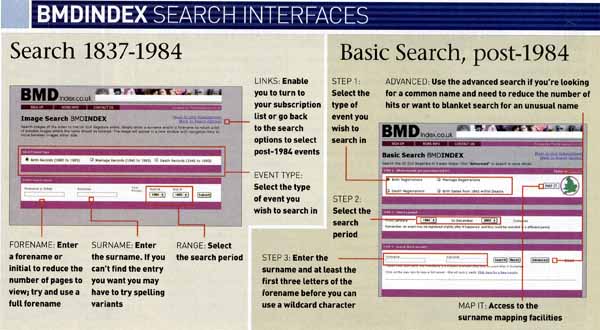 |
|
 |
 |
 |
TIP
Omissions
Manually compiled indexes have omissions and mistakes, these are no exception. If you cannot find an entry, it's worth checking with the local registrar (if you know which area), as they use a different index systems, and can often find records that are missing from the main GRO indexes. |
SEARCHING DEATH RECORDS
My mother recalls Sunderland-based Fowle relations from her childhood. Let's try the recent deaths entries
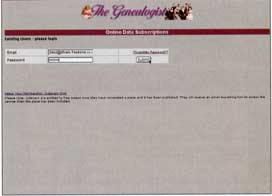
[1] From the BMDindex home page choose the Sign up link, enter your details and choose a password. On the next screen select the services you want to subscribe to and go to the secure credit card page to finish.

[2] You can now log in to the site with your email address and password. If you signed up for several services select the BMDindex link from your subscription list. Select the 1984-2003 BMD records and click Search Now.
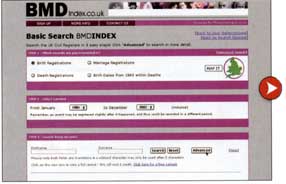
[3] This brings the Basic search page, but as I wanted to blanket search for the name Fowle, I need the Advanced search page which doesn't require a forename or initials. Click the Advanced search button.
|
plus the 1851 Two Per Cent Sample Census for England and Wales. Herefordshire has full census indexes for 1851, 1891 and 1901, with the latter year linked to the census enumerator's book images. This is a feature which S&N intends to add to other census indexes in due course. Lincolnshire and Wiltshire have complete 1891 Census indexes, Worcestershire has a full census transcript for 1851 and there are a lot of partial census indexes available too. The other complete dataset available at present is the Merchant Navy Crew lists and agreements for the years 1863 to 1913.
You can sign up for your choice of a range of indexes, databases and services using Barclaycard EPDQ for secure payment.
Although the BMDindex isn't quite complete yet, the births
|
births should be back completed by the time you read this, with the marriages and deaths following close behind. However BMDindex is not just a copy of existing commercial BMD sites, the service has some innovative features not available on rival services.
POST-1984 INDEXES
Since 1984 the GRO indexes have been fully computerised and thus are much more accessible- they have their own separate pages. The basic search requires only a surname and forename, although you can use the wildcard character * after the first three letters. That's fine if you are looking for say the birth of a specific person, but they may have had siblings that you didn't know about, which this search wouldn't find. Using the Advanced Search page you can
|
"Reduce the number of hits by entering forenames or initials, the mother's maiden name, and the year, month and district of registration" |
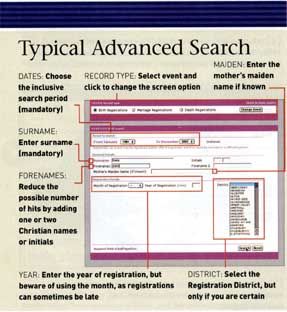 |
|
 |
 |
 |
Searching death records, continued...
|
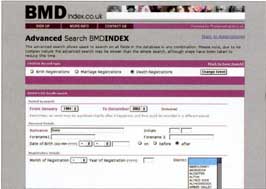
[4] On the Advanced Search page we can just enter the surname Fowle. For a more common name this would probably have to be supplemented by a registration area to make the number of results more manageable. Click Search. |
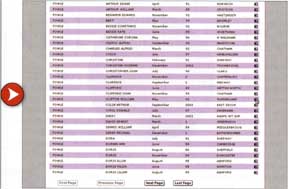
[5] Looking through the resulting entries I found Clifton William Fowle who died in 1992 in Sunderland district. Click the link beside his entry to view the full details. |
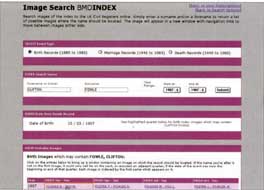
[7] This brings a search results page from the pre-1984 section, with the most likely quarter for the event, based on the birth date information, already highlighted. Click on the link to view Fowles A-Fox M. |
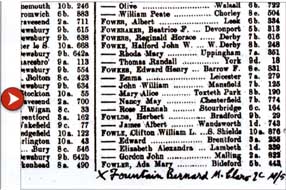
[8] A new window opens to display the index page. Clifton William isn't on the March quarter page, but he is on the June quarter, registered in South Shields. I now need a certificate to establish his parents. |
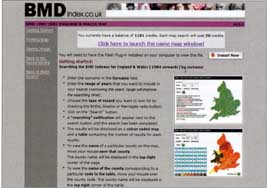
[10] The page explains the mapping process and costs. You need the Flash plug-in installed for your browser to run the mapping facility. There is a link to download this if you haven't already installed it. |
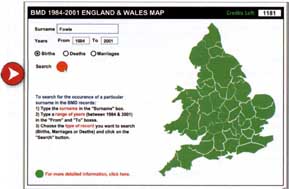
[11] In the mapping window which appears, Select the Surname- Fowle; period of years From 1984-2001; the event type- Births, and then click Search.
|
|
 |
 |
 |
Searching death records, continued... |
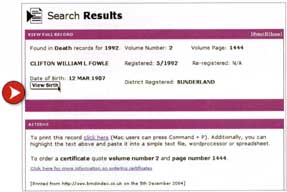
[6] The full details show that he was born on 12 March 1907. You can now use the Smart Search facility to find his birth registration. Click the View Birth button. 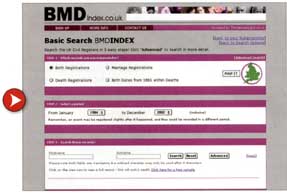
[9] Next let's create a surname distribution map on BMDindex. The mapping is reached via the link on the Basic search page of the post-1984 section of BMDindex. Click the Map It link on the top right of the page. 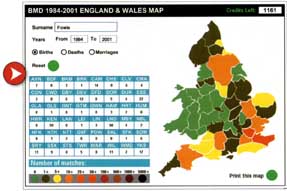
[12] The result shows a distribution map of the recent Fowle birth registrations indicating the highest density in London and Kent. However, it shows that there are none in Wales, and few in the western counties. |
TIP
Order at the GRO
Having looked up your reference online, go to the GRO's online certificate ordering system and order your copy certificates. They cost £7 each and - ususally - arrive in approximately four working days. Visit www.gro.gov.uk/gro/content/certificate |
enter just a surname if you wish, and find all surname entries for a selected period. For more common names you can use the advanced options to reduce the number of hits by entering up to two initials or forenames, the mother's maiden name, the year and month of registration and the district.
Unlike its rival, 1837online, searching the post-1984 data here doesn't just come up with a result that says, "There are 18 entries that match the search criteria... To view these will cost 18 units". Using the index is free and the initial search results contain a near complete set of the information contained in the index, so you can be fairly sure you have the correct entry before you use your single credit to view the full entry. The extra information bought by your one credit, for instance when looking up a birth, consists of the mother's maiden name and the page and folio numbers necessary to order a copy certificate.
SMART SEARCH FACILITY
BMDindex has more functionality not available on rival services. The Smart Search function performs a variety of useful look-ups based on the recorded data. The marriage entries have a reverse search facility of the spouse's surname in an entry, which enables you to instantly find first names.
The death registration search enables you to automatically locate the likely index pages with the birth of an individual based on the date of birth recorded in the death entry- this only works with males and spinsters. A similar facility is being added on the birth lookups to try to locate related family entries which should find likely siblings and any possible marriage for the mother. You can also search post-1984 entries by the birth date entries they contain.
SURNAME MAPPING
A unique and useful feature is the ability to map the distribution of surname events onto a county map of England and Wales.
|
Originally you could map just births, marriages or deaths over any year range on the 1984-2002 period. This produces a colour-coded distribution map and table of the actual number of events. The feature has been extended using statistics from the GRO and looks at all the BMD surname events over seven different periods covering the date ranges 1880-1900 to 1992-2002. Particularly if your surname has a limited distribution on the 1880 map, it's surprising how it spreads across the country through the years.
1837-1984 ENTRIES
Before 1984 BMDindex, like other commercial services, uses the page images of the original typed and handwritten GRO indexes. Because the quality of the typed indexes is too poor to use optical character recognition software to create searchable indexes, every page has been indexed by the first and last name it contains. Thus a search will always find a page your entry may be found on, because it contains the range of names that fits your search criteria. This points you accurately to the index pages to view for each three-month, quarter period, meaning fewer records to view.
COSTS
Unlike the census indexes on TheGenealogist.co.uk which have a flat rate subscription of £5 for three months (or £14.95 per year), the BMDindex service allocates you credits which are deducted when you view records or create distribution maps. The basic subscription costs £5 which gives you 50 credits which last for up to three months, and for £14.95 you get 200 credits which last for up to a year. The basic 50 view credits will go a long way, especially with the free-indexing of the post-1984 results, which can rapidly swallow up your credits on 1837online. The maps use up credits faster, costing ten or 20 credits each.
|
|
 |
 |
By David Fowle
|
|